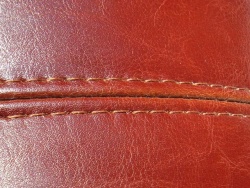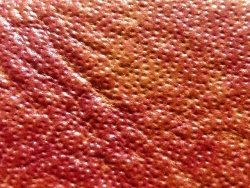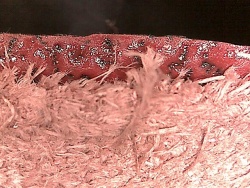Difference between revisions of "PU leather"
| Line 109: | Line 109: | ||
<p align=center> | <p align=center> | ||
| − | <flashow>//www.youtube.com/v/ | + | <flashow>//www.youtube.com/v/XHvtYIjY_Tg&fs=1&color1=0x660000&color2=0x550000&border=1|width=500|height=281,25</flashow> |
</p> | </p> | ||
<p align=center> | <p align=center> | ||
Revision as of 09:22, 15 June 2019
Contents
PU-leather
PU leather is a split leather that has been laminated with a polyurethane coating to make it look like a top grain leather. Usually, these leathers have a glossy surface and an antique look. PU leather is used for furniture and shoes.
Video about the production of laminated split leather.
Other names for this material are "Bycast leather", "Bicast leather" and "Polyurethane-coated leather". Sometimes, "PU" is mixed up with "Pull-Up leather", which is an oiled/waxed leather.
As the use of the term PU leather is different in every country, always ask which material is used.
Imitation leather is also sold in the same look. This artificial leather also has a polyurethane coating on top.
The advantage of PU leather is the inexpensive price range. Split leather is inexpensive, but it is not particularly durable and therefore often suffers damage after only a few years. Additionally, there is a lack of breathability. Due to the strong coating, the leather feels colder than uncoated or thin coated leathers and sticks to the skin easily.
Usually, these leathers are not declared as split leather which is incorrect customer information. Customers can't see that below the grain surface is a low quality split leather. If the film thickness of the coating is greater than 0.15 millimetres, these leathers must be declared as "coated leather". In countries such as Denmark or New Zealand, the term "genuine leather" for such leather types is forbidden.
If in doubt, ask if the offered material is a coated split leather. If you are only concerned about the price, you can buy it. If you want good quality, a breathable and natural product, coated leather is out of the question.
Typical PU leather furniture. - At first glance, like a top grain leather.
The hair pores in the coating are embossed.
Split leather with glued foil on top.
The foil on the split leather is clearly recognisable.
Microscopic photo of the surface of a PU leather. The dark spots are caused by air inclusions in the plastic coating.
Typical damage to PU leather in the furniture area
After a few years, damages occur to the foil-coated split leathers. Tearing and colour separation in the load area is typical when the split leather is too weak and stretches excessively. Wear marks of the coating in the hair or skin contact areas are common. The film becomes dull, sticky and sometimes whitish. Such damages are irretrievable in most cases.
The causes of damages: Detachment of the coating, cat scratches, dogs claws.
PU with problems of colour separation
On some PU leathers, the foil peels off from the split leather. After 2 and 5 years.
Condition after 5 years.
Dye transfer from leather and colour separation of leather.
PU leather with problems of shifting the coating
ON some PU leathers, the coating smears and shifts in the contact area with skin or hair.
PU leather with problems of layer resolution in the head area
On some PU leathers, the area with hair contact gets dull, sticky and/or whitish.
PU leathers, which tear because of lack of stability of the split leather
Frequently the leather tears due to lack of stability of the split leather.
Often these damages occur after 2-4 years, which is in most countries after the warranty period. Therefore, it is always advisable to ask the dealers to confirm in the purchase contract that it is not a split leather or coated split leather.
PU-imitation leather
The PU synthetic leather is optically identical to the coated PU split leather. Experts can recognise the softer haptic and the higher elasticity when heated. PU artificial leather is inexpensive and is often found in public waiting areas such as hotels or department stores.
Typical PU imitation leather.
Additional information
- What materials can be called leather?
- Coated leather - Laminated leather
- What should be considered when buying new leather furniture?
Other leather damages
- Typical leather damage such as ageing, fading, stains etc.
- Dye transfer from leather
- Flamingo effect: reddish discolorations in bright furniture leather in unseen area
- Metallic discoloration on new leathers. Mostly clothing leathers.
- Adhesive migration – Glue migration
- Moldy leather - Mouldy leather
- Fatty spue - Fat marks on leather
Additional information














































 a kotori web solution
a kotori web solution